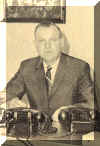| Because You Asked . . . . | ||||
|
|
||||
|
Aroma of Fresh Brewed Coffee from Sunbury's South Columbus Street |
||||
|
Creamery to Baby Food to Coffee |
||||
|
John Wildi Evaporated Milk Company (formerly Sunbury Co-Operative Creamery) was sold in 1919 to Nestle Alimentania, S. A. Butter, cheese and evaporated milk were still the primary products. In 1865 in Vevey, Switzerland, Henri Nestle, a merchant with a homemade laboratory, had been working on a baby food
product when an infant in the town was born with no tolerance to breast milk or existing milk products. It was decided to
give Henri's invention a try because the boy would surely die otherwise. The baby not only survived, he appeared to be
very normal in every way. Word of such a miracle spread rapidly. In 1868 the medical profession had approved the baby
food product and production began in Switzerland. Thus started the world wide company which came to Sunbury. In a small corner of the baby food manufacturing plant, a handful began to turn out an instant coffee called Nescafe. Although much of the research happened elsewhere, in 1939, before convenience foods were popular, Sunbury produced 350 pounds of instant coffee an hour. In 1943 they received the Army-Navy E Award for high achievement in producing Nescafe for every serviceman's ration pack. The pleasant aroma of brewed coffee covered the area and resulted in more than one person stopping in the town to inquire about its source. The cup on top of the plant with the steam coming up from behind it became a Sunbury trademark. On the negative side, I hated hanging out white sheets to dry on a day they cleaned their stacks and the sheets were covered with brown residue. The Sunbury plant was the first to produce instant tea, Nestea, in 1946. In 1968, Sunbury added the first continuous Freeze Drying process and added Taster's Choice to the coffee line. This became the primary product from Sunbury. In 1981, a $27 million five story addition for a natural decaffeination plant was built in Sunbury. Daily the plant removed 2,500 pounds of caffeine from a million pounds of coffee beans and sold it to Coca-Cola for use in soft drinks. Caffeine became the new primary product for this plant. Nestles was always a good neighbor. A big user of water, they helped the village provide up ground reservoirs for water storage, built a water tower to provide water for their plant and extra water for the village when needed. In 1952, when the village ran low on water, Nestles provided tank trucks to haul water as well as helped open a channel to move water pocketed near the roadside park north of Sunbury. 1979 Nestles replaced a sewer line which also drains part of Sunbury. $500,000 was given to Sunbury for water system upgrades shortly before word came the plant was to close. The company was always looking for better ways to get rid of the waste from the company. In 1961 coffee-colored waste water from instant coffee was diverted to a 750,000 gallon lagoon so the coffee could settle out and the waste water sprayed on fields. 1980 Nestles and Young Environment Services began injecting liquid wastes from the plant on Paul Miller farm to see what kind of an impact it would have on the environment.. The unpleasant odor replaced the pleasant coffee aroma of earlier years.. Nestles and Hills Company merged in May 1991 and became the Nestles/Hills Brothers Coffee Company and then Nestle Beverage Company. Unfortunately decaffeinated coffee did not continue to be popular so it was announced in 1993 the Sunbury plant would close. Colin Swift, plant manager, worked hard to help his dedicated employees find new jobs At the time it stopped production, Nestles was responsible for 32% of the village income tax, 40% of the water fees, and owned 250 acres of land.. Many thanks to Verna Bergandine and her Nestle Scrapbook for the company's history. The scrapbook is in Community Library. |
||||
 |

1920 Baby Food Ad found by |
|||
|
Early Nestle Photo |
Left, E.C. Teut, plant manager
honors |
Mid 1930s | ||
 |
 |
 |
Ralph H. Clark Herbert Kempton Frank Frey |
 |
|
Frank Bergandine |
Aerial View |
Nestles Basketball Team |
Columbus Street |
|
|
1979 |
||||
|
Begin Injecting Taster's Choice
Waste into Miller farm land - October 1980 |
1981 Crane used to lift equipment onto plant |
|||
|
Watching July 4th Parade |
|
More photos coming soon |
The demise of the building | |
|
. . . .And Now You
Know
|
||||
| Go to the
Removal of the Building Return to Local History Index |
(08/20/2011 ) |
|||